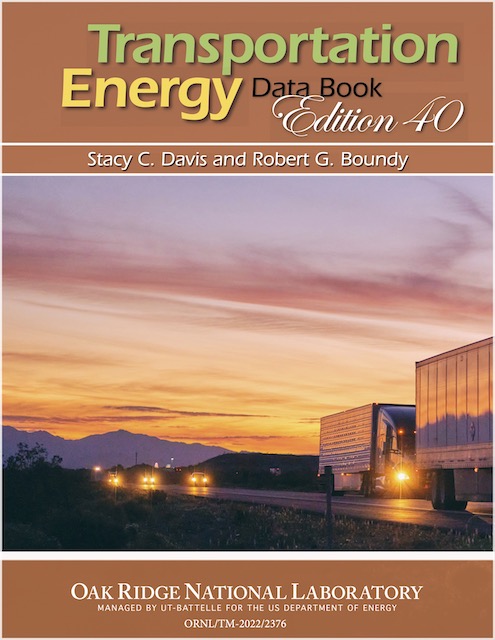The average car used less than 2,800 British thermal units (BTUs) of energy per passenger-mile in 2019, according to the latest edition of the Department of Energy’s Transportation Energy Data Book. This is nearly a 25 percent improvement since 1999. It also made cars more energy efficient than transit in every urban area in the country except New York and San Francisco.
 Click image to download a 16.4-MB PDF of this report. Click here to download Excel spreadsheets for the 361 tables in the report (11 MB).
Click image to download a 16.4-MB PDF of this report. Click here to download Excel spreadsheets for the 361 tables in the report (11 MB).
The Department of Energy releases its annual update to the data book every February, but I wasn’t paying attention when the last one came out. In fact, it doesn’t say a lot that’s new since the previous one was issued in 2021, but it shows that both autos and airplanes continue to improve their energy efficiencies, the latter by 42 percent since 1999.
The pandemic, however, will make the next editions of the book particularly interesting. Transit agencies have been operating at 85 percent of pre-pandemic service levels (which means they are using 85 percent as much energy) even though ridership remains less than 60 percent of 2019 numbers. That means transit has become far less energy efficient. Amtrak will have similar problems, while the airlines cope with reduced patronage by reducing their service, a concept that seems foreign to government-operated transportation agencies.
One big question will be how the pandemic affected average automobile occupancies. On one hand, people may be more reluctant to travel with friends. On the other hand, increased telecommuting means reduced single-occupancy vehicles on the road during morning and afternoon rush hours. I suspect the latter effect will swamp the former, in which case higher occupancies will translate into increased energy efficiencies. We’ll find out when the Department of Transportation publishes the results of its 2022 National Household Travel Survey.








This is interesting because the AP states that cars are more energy efficient than transit, but in my experience the average US citizen doesn’t think so. He also states that Cities have a lower carbon footprint than suburbs, but average US citizen doesn’t I think that is correct either.
Okay let’s put a pin in that theory by understanding basic energy physics.
The biggest defect to transit energy efficiency is capacities. Don’t tell me a guy in a super duty riding alone to a 7/11 for a pack if smokes…is morevenergy efficient than a trolley running on electricity.
Height of transit ridership, streetcars and heavy rail systems generated their own electricity…they built powerhouses to run their systems, also residual steam ran cities steam commercial business. The .out famous being IRT powerhouse in New York City.
Some green buildings use natural gas and thru gas turbines (which have gotten amazingly small thanks to helicopter ? and jet plane ? industries) generate their own power on-site…. by eliminating the thermodynamic losses of distant powerplant to source transmission.
Improving transit transit capacity increases efficiency by decreasing per capital energy consumption. Problem with per capita stats is stats get bucked by outliers.
Living up to his name? I guess LR did not bother to read the calculation methodology, preferring instead to assemble a few odd examples of his choosing.
https://ti.org/pdfs/APB85.pdf
No… it’s per capita.
https://external-preview.redd.it/vdKQf24LJ0aEPGdjTWhFQSY6zMSH9z_MYfiqijW-BOQ.jpg?width=640&crop=smart&auto=webp&s=ee5e632a093ad5f5240575ac21bd249c7d1ed654
Average fuel economy of US fleet vehicles is 24.6 mpg, data by US department of Energy….. 40 years of CAFE standards…. 120 Megajoules in a gallon on gas, 25 mpg, 5 Megajoules per mile or 4800 BTU per passenger mile.
You left out a step to get to “BTU per passenger mile” — which is average passenger vehicle occupancy.
The latest I’ve seen reported is 1.67.
4800 BTU per vehicle mile ÷ 1.67 passengers per vehicle = 2,875 BTU per passenger mile.
”
Don’t tell me a guy in a super duty riding alone to a 7/11 for a pack if smokes…is morevenergy efficient than a trolley running on electricity.
”
~lazReader
Don’t tell me is quite redundant. Your framing made it quite clear you have no interest exploring that issue.
For those that do, an F250 weighs 1/8th of a trolley. An F150, 1/10th.
There are 10-15 times more F150s sold each year than F250s. F250s are rarely sold to people who don’t have a a business need ( the extra towning capacity ).
It’s rare to none you’ll find someone driving a F250 for anything but work.
But in the off chance you did, they’d require 8 times less the energy to get that pack of smokes than someone taking the trolley.